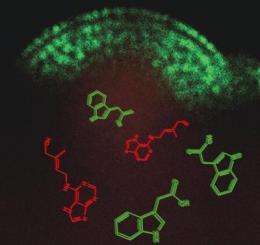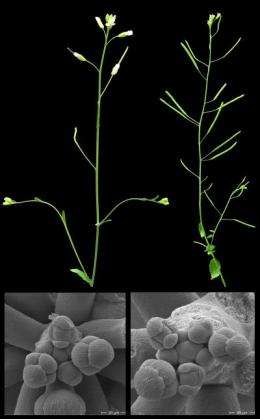Plant growth hormones: Antagonists cooperate

The two most important growth hormones of plants, so far considered antagonists, also work synergistically. The activities of auxin and cytokinin, key molecules for plant growth and the formation of organs, such as leaves and buds, are in fact more closely interwoven than previously assumed.
Scientists from Heidelberg, Tubingen (Germany) and Umea (Sweden) made this surprising discovery in a series of complex experiments using thale cress (Arabidopsis thaliana), a biological reference organism. The international team of researchers, led by Jan Lohmann, stem cell biologist at Heidelberg University, have now published their results in the scientific journal Nature.
All the above-ground parts of a plant - leaves, buds, stems and seeds - ultimately arise from a small tissue at the shoot tip, which contains totipotent stem cells. Since plant stem cells remain active over the entire life of the organism, plants, unlike animals, are able to grow and develop new organs over many decades. On the periphery of the tip, auxin triggers cells to leave the pool of stem cells, differentiate and form organs like leaves and buds. Cytokinin stimulates stem cells to divide and proliferate; it maintains the number of cells and thus the plant's growth potential.

Some of the genetic factors involved in cytokinin's effect on plant growth were already known. In the thale cress experiments, which concentrated on the growth zone at the tip of the shoot, Lohmann and his team now studied the role of auxin in the interplay of the two hormones. It turns out that auxin directly interferes with a feedback loop involving two genes activated by cytokinin - ARR7 and ARR15 - which limit the effect of cytokinin. Auxin suppresses these two genes, thereby boosting the effect of cytokinin.
"Auxin acts to support the pool of stem cells", explains Jan Lohmann. "When it triggers cells at the periphery of the growth zone to form organs, it still needs to ensure that enough stem cells are supplied." This keeps the number of stem cells from falling below a critical minimum, which is key for plant growth and survival. "We're gradually beginning to understand how hormonal and genetic factors are interwoven to maintain the activity of the growth zone. We now know that hormones and genes interact in multiple ways, each one affecting the other. There are no solitary factors."
More information: Z. Zhao, S.U. Andersen, K. Ljung, K. Dolezal, A. Miotk, S.J. Schultheiss, J.U. Lohmann: Hormonal control of the shoot stem-cell niche, Nature (24 June 2010), doi: 10.1038/nature09126
Provided by Max-Planck-Gesellschaft















